Ladies, have you ever struggled with performing the women’s bent over dumbbell row exercise? Where you try to execute the motion but somehow can’t seem to activate the intended muscle group? Don’t worry, you’re not alone! Many women find that this exercise can be extremely challenging. The root of the problem may lie in the form of execution or failing to engage the correct muscle group. In this blog post, we will take a closer look at the common mistakes made with the women’s bent over dumbbell row and provide you with easy-to-follow tips to ensure proper form and maximum efficiency in this vital exercise.
Bent Over Dumbbell Row Summary
- Primary Muscles: Deltoid – Posterior
- Secondary Muscles: Brachialis, Brachioradialis, Infraspinatus, Latissimus Dorsi, Rhomboids, Teres Minor, Trapezius – Lower, and Trapezius – Middle
- Equipment: Dumbbells
- Mechanics Type: Compound
- Force: Pull
- Utility: Basic
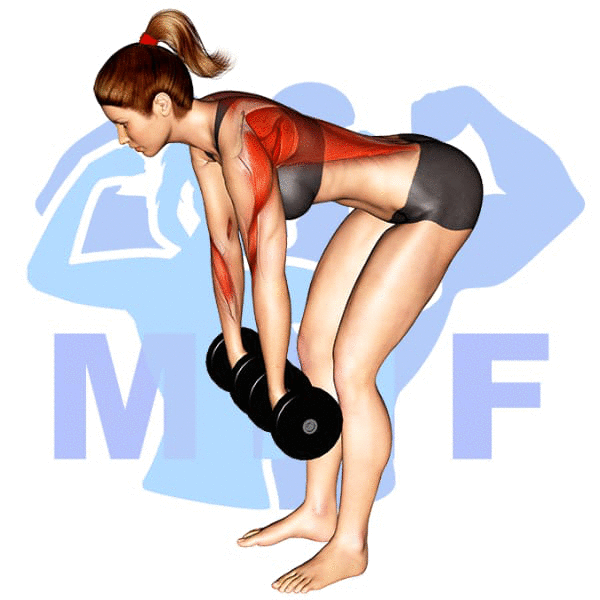
Bent Over Dumbbell Row Instructions
- Place a dumbbell on the ground with one hand on either side of the weight.
- Bend forward at your waist so that your torso is parallel to the ground.
- Keep your back straight and your knees slightly bent.
- Grab the dumbbell with both hands, palms facing each other.
- Pull the weight up toward your chest, keeping your elbows close to your body.
- Pause at the top of the movement, squeezing your shoulder blades together.
- Lower the weight back down to the starting position.
- Repeat for desired number of repetitions.
Video Tutorial
Bent Over Dumbbell Row Muscles
Target (Agonist)
Synergists
- Brachialis
- Brachioradialis
- Infraspinatus
- Latissimus Dorsi
- Rhomboids
- Teres Minor
- Trapezius – Lower
- Trapezius – Middle
Dynamic Stabilizers
Stabilizers
Antagonist Stabilizers

Benefits of Bent Over Dumbbell Row
The Bent Over Dumbbell Row is a great exercise to add to any strength training or fitness routine. It specifically targets the posterior deltoid muscle, located at the back of the shoulder, helping to strengthen and tone it. This exercise also helps to improve posture and balance, while engaging other muscles like the biceps, upper back, lower back, and glutes. Additionally, performing this exercise regularly can help to improve core strength and stability. Finally, the Bent Over Dumbbell Row is an excellent exercise for developing overall upper body strength and power.
Tips for Performing Bent Over Dumbbell Row
The bent over dumbbell row is a great exercise for anyone looking to strengthen and tone their upper back muscles. It’s a simple, yet effective, exercise that can be performed with just a pair of dumbbells. Not only will it help you build strength, it also helps to improve posture and balance. To get the most out of this exercise, follow these tips:
- Conduct Power Sets. One way to execute a power set is conduct two sets back to back on complementary muscle groups. For these rows a complementary set could be a dumbbell press. Another way to do a power set would be to do a set using the same muscle group, such as do a set of these rows, then do bicep curls.
- Perform at Least 3 of 8-20 Repetitions for Hypertrophy. You should know that there are many theories regarding how Hypertrophy is initiated, and most come to an agreement that sets using 60-80% within your 1RM are going to resulted in increased muscle size. Don’t wory ladies using muscle hypertrophy will not make you look like a muscle bound man, but it will help you develop curves in all the right places.
- Slow Each Repetition Down to 4-6 Seconds for Every Contraction and the Same for the Extension, to Boost Your Training. You will generate fatigue in your muscle more quickly my raising the time under tension of your target muscle tissue. Multiple research papers have shown that just under 6 seconds extension and contraction is the ideal time and provides optimum benefit for creating muscle gains. You should add this approach occasionally, however, not every-time you train.
Benefits and Tips Video
Frequent Mistakes To Avoid
It’s important to take note of the common mistakes associated with bent over dumbbell rows so you can maximize your results while avoiding potential injury. Incorrect form and posture can lead to muscle imbalances, weak muscles, back pain, and other injuries. Knowing what to avoid will help you maintain proper form and get the most out of your workout.
- Don’t Relax Your Core. Keeping your core tight protects your spinal column by maintaining your internal pressure.
- Don’t Disregard Any Discomfort. Sore muscles are a good thing, they are telling you that you worked your muscles well enough that they are going to get stronger, if you let them rest and rebuild. If you don’t let them rest you are more prone to an injury. If you feel pain and not just soreness than you likely have an injury and you need to take it easy and let your body heal or it will get even worse.
- Try Not to Rush Your Training Session. When you speed through your work out you are more likely to have poor form and be more prone to having an accident.
Find More Dumbbell Exercises Here
Variations and Complementary Exercises
If you’re looking to switch up your workout routine, there are many variations, complementary, and alternative exercises that can help you target the same muscles as the Bent Over Dumbbell Row. Below is a list of some of these exercises, each of which will help you build strength and muscle in the same areas.
Seated Underhand Cable Row

The Seated Underhand Cable Row is an excellent alternative or complementary exercise to the Bent Over Dumbbell Row. This exercise targets the same muscle groups as the Bent Over Dumbbell Row, but in a slightly different way. It involves sitting on a bench or chair with a cable attachment secured around your feet. You then pull the handle towards your chest, keeping your back straight and your arms close to your body. This exercise works the lats, rhomboids, biceps and traps for a complete back workout. It also allows for greater range of motion than the Bent Over Dumbbell Row, making it an ideal choice for anyone looking to target those muscles with more precision.
Inverted Row

The Inverted Row is an excellent complementary or alternative exercise to the Bent Over Dumbbell Row. It is a bodyweight exercise that works the back, biceps, and core muscles. It can be performed with a suspension trainer, an Olympic barbell, or simply with a sturdy table or chair. The motion of the exercise involves pulling your chest up to the bar while keeping your torso in a straight line. This exercise focuses on developing strength and stability in the back muscles, while also working the biceps and core. The Inverted Row can be used to supplement the Bent Over Dumbbell Row as it works many of the same muscle groups but with a slightly different range of motion.
Reverse Grip Bent Over Dumbbell Row
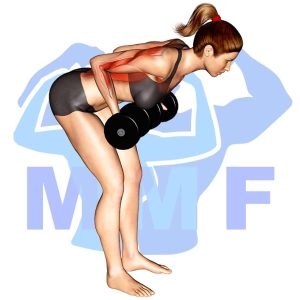
The Reverse Grip Bent Over Dumbbell Row is a great complementary or alternative exercise to the Bent Over Dumbbell Row. This exercise is performed by standing with your feet shoulder-width apart, holding a pair of dumbbells with your palms facing inwards and bending at the hips until your torso is parallel to the floor. Then, keeping your core tight and your back flat, you row the dumbbells up to your chest, then lower them back down. This exercise helps to target the upper back muscles and improve posture, as well as providing an effective workout for the biceps and shoulders.
Check Out These Top Dumbbell Exercises
Bent Over Rotating Dumbbell Row

The Bent Over Rotating Dumbbell Row is a great complementary or alternative exercise to the Bent Over Dumbbell Row. It works the same muscles as the standard row, but adds an additional challenge by involving the core and obliques to stabilize the body while rotating the weight. This helps to develop better balance and stability while also engaging more of the muscles in the back. Additionally, this exercise can help to improve posture, strengthen the upper back and reduce risk of back pain.
Dumbbell Lateral Raise

The Dumbbell Lateral Raise is an effective exercise for targeting the shoulders. It is an excellent complementary or alternative exercise to the Bent Over Dumbbell Row, as it works the same muscle group, but in a different way. The Dumbbell Lateral Raise focuses on isolating the shoulder muscles, while the Bent Over Dumbbell Row works both the shoulder muscles and the back muscles. This allows for a full-body workout that will target all of the muscle groups needed for a strong and healthy upper body.
Straight Arm Lat Pulldown
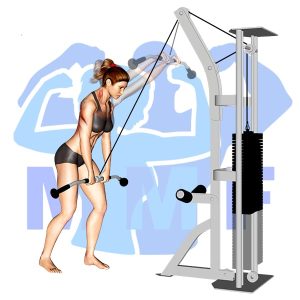
The Straight Arm Lat Pulldown is a great complementary or alternative exercise to the Bent Over Dumbbell Row. This exercise works the lats and upper back, helping to create a strong and stable posture. It can be done either with a cable machine or with a resistance band. To perform the exercise, sit on a bench and grasp the handle or band with both hands, keeping your arms straight and chest up. Pull the handle or band down towards your thighs, hold for a count of two, then slowly return to the starting position. This exercise is an effective way to strengthen your back muscles and build strength in your lats.
Find More Back Exercises Here
Opposing Complementary Exercises
In addition to the Bent Over Dumbbell Row, there are other exercises that can help to balance your workout and build a strong, healthy body. To get the most out of your exercise routine, it is important to incorporate exercises that work opposing muscle groups. Here are some exercises that complement the Bent Over Dumbbell Row by working opposing muscles:
Resistance Band High Chest Flys
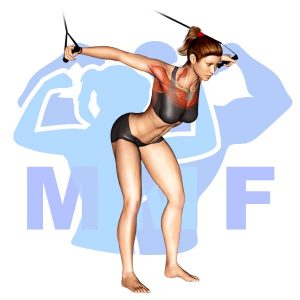
Resistance Band High Chest Flys are a great complementary exercise to Bent Over Dumbbell Rows because they work the opposing muscle group. Resistance Band High Chest Flys help to strengthen and tone the chest, while Bent Over Dumbbell Rows focus on the back muscles. By doing both exercises together, you can help to balance out your upper body strength, and improve your posture and overall fitness. This pairing of exercises is an effective way to build strength and stability throughout your entire body.
Resistance Band Flys

Resistance Band Flys are a great complement to the Bent Over Dumbbell Row because they target the opposing muscle group of the back. Resistance Band Flys involve standing with feet hip-width apart, grasping the handles of the resistance band with palms facing inwards and extending your arms out to the side. As you pull the handles back in towards the body, you should feel your chest and shoulder muscles activating. This exercise effectively targets the pectoral muscles, which are the opposing muscles to those used in Bent Over Dumbbell Rows. The combination of these two exercises allows for an effective full-body workout that targets both muscle groups.
Resistance Band Chest Press
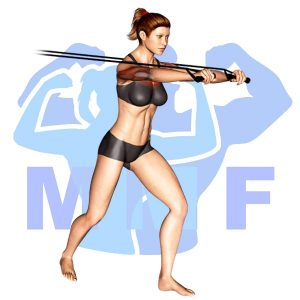
The Resistance Band Chest Press is a great complement to the Bent Over Dumbbell Row. It focuses on the pectoral muscles, which are the opposing muscle group to the lats and traps used in the Bent Over Dumbbell Row. This exercise also helps to build strength and stability in the chest area, as well as helping to maintain good posture. By alternating between these two exercises, you can work both sets of muscles and get a balanced and effective workout.
Maximize Your Results with Women’s Dumbbell Rows
Maximizing your results with women’s dumbbell rows is a great way to challenge your back muscles and work towards a toned upper body. By mastering proper form and gradually increasing weight, you can increase the intensity of your workouts and see noticeable improvements in your strength and muscle definition. Make sure to maintain a strong, stable position throughout the exercise and focus on the contraction of your back muscles with each repetition. Consistency is key, so aim to incorporate dumbbell rows into your workout routine at least once a week for optimal results.
References: Wikipedia | ExRx.net | PubMed.gov | Comprehensive List of Back Dumbbell Exercises


